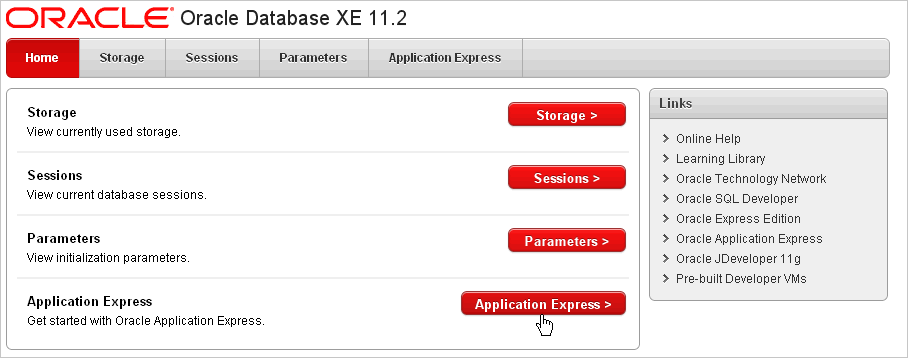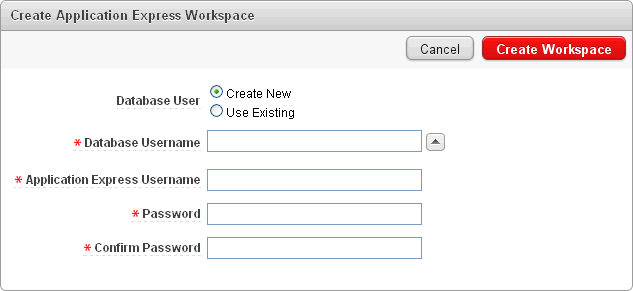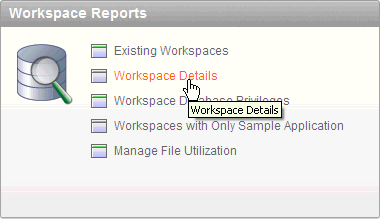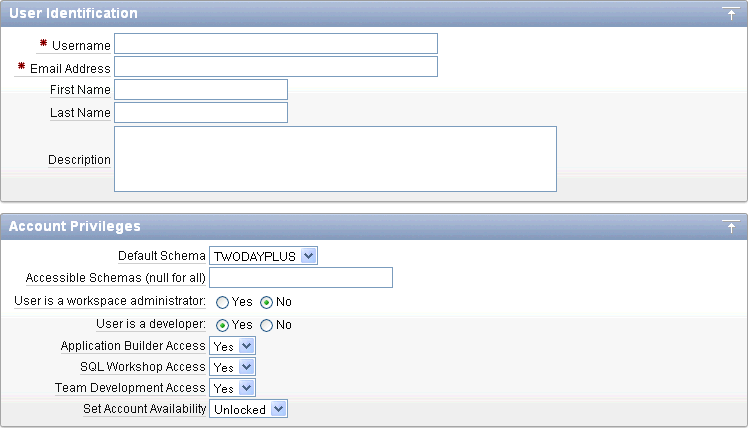2 Accessing Your Development Environment
This section guides you through the steps needed to access an Oracle Application Express development environment.
This chapter assumes that you have installed Oracle Database Express Edition (Oracle Database XE) on your Windows or Linux system, as described in Oracle Database Express Edition Installation Guide for Microsoft Windows and Oracle Database Express Edition Installation Guide for Linux.
Before You Begin
Before you begin this section, do the following:
-
Install Oracle Database XE as described in Oracle Database Express Edition Installation Guide for Microsoft Windows and Oracle Database Express Edition Installation Guide for Linux.
-
Confirm your Web browser supports JavaScript and the HTML 4.0 and Cascading Style Sheet (CSS) 1.0 standards. The following browsers meet this requirement:
-
Microsoft Internet Explorer 7.0 or later version
-
Mozilla Firefox 3.5 or later version
-
Google Chrome 4.0 or later version
-
Apple Safari 4.0 or later version
-
-
Enable cookies for your Web browser.
Accessing Oracle Application Express from the Database Home Page
The Database Home page is a Web browser-based interface that enables you to perform various database administration operations, including monitoring database storage, monitoring database sessions, and viewing database initialization parameters. In Oracle Database XE, you use the Database Home page to initially access Oracle Application Express.
Creating Login Credentials from the Database Home Page
This section explains how to create a workspace and log in to Oracle Application Express from the Database Home page. Once you create a workspace, username, and password, you can access Oracle Application Express directly from your Web browser as described in "Logging In to Application Express Administration Services" and "Logging In to the Application Express Development Environment".
To create login credentials from the Database Home page:
-
Navigate to the system menu:
-
Windows - From the Start menu, select Programs (or All Programs), then Oracle Database 11g Express Edition, and then Get Started.
-
Linux - Click the Application menu (on Gnome) or the K menu (on KDE), then point to Oracle Database 11g Express Edition, and then Get Started.
The Oracle Database XE home page appears.

Description of the illustration xe_home_pg.gif
For detailed information about using database-level operations, see Oracle Database Express Edition 2 Day DBA.
-
-
Click the Application Express button.
The Login page appears.
-
On the Login page:
-
Username - Specify a database user who has been granted the DBA database role (for example,
SYSTEM). -
Password - Enter the database user password you created during the installation process.
-
Click Login.
The Create Application Express Workspaces page appears.

Description of the illustration xe_create_wrkspc.gif
-
-
On the Create Application Express Workspaces page:
-
Database User - Select Create New.
-
Database Username - Enter
TWODAYPLUS -
Application Express Username - Enter a unique username (for example,
TWODAYPLUS). -
Password - Enter a password.
-
Confirm Password - Re-enter the password.
Tip:
Make a note of your login credentials. -
Click Create Workspace.
The Database Home page appears. A message appears at the top of the page.
-
-
Click the click here ink in the message that displays:
Successfully created workspace 2DAYPLUS. To begin, click here to login. -
Change your password and click Apply Changes.
-
Click Return.
-
Enter the your new login credentials and click Login.

Description of the illustration login.gif
The Workspace home page appears.
About the URL Where You Access Oracle Application Express
Make a note of the URL that displays in your Web browser when the Workspace home page appears. You can use this URL to log into Oracle Application Express directly. The URL appears in the format:
http://hostname:port/apex
Where:
-
hostnameis the name of the system where Oracle XML DB HTTP server is installed. -
portis the port number assigned to Oracle XML DB HTTP server. In a default installation, this number is 8080. -
apexis the database access descriptor (DAD) defined in the configuration file.
Logging in to Application Express with an Existing Account
To log in to Oracle Application Express from the Database Home page using an existing account:
-
Navigate to the system menu:
-
Windows - From the Start menu, select Programs (or All Programs), then Oracle Database 11g Express Edition, and then Get Started.
-
Linux - Click the Application menu (on Gnome) or the K menu (on KDE), then point to Oracle Database 11g Express Edition, and then Get Started.
The Oracle Database XE home page appears.
-
-
Click the Application Express button.
The Login page appears.
-
On the Login page:
-
Username - Specify a database user which has been granted the DBA database role (for example,
SYSTEM) -
Password - Enter the database user password you created during the installation process.
-
Click Login.
-
-
Under Getting Started:
-
Click the Already have an Account? Login Here button.
A login page appears.
-
Enter your login credentials.

Description of the illustration login.gif
-
Click Login.
The Workspace home page appears.
-
Understanding and Configuring Your Local Environment
Instead of using the Database Home page to access Oracle Application Express, you can also access and configure Oracle Application Express directly.
Note:
This tutorial explains a simplified approach for setting up your development environment so that you can begin using Oracle Application Express. However, to set up your development environment to accommodate real-life development needs, review “Oracle Application Express Hosted Instance Administration" in Oracle Application Express Administration Guide.Logging In to Application Express Administration Services
In Oracle Application Express, you can create multiple areas (or workspaces) where you develop applications. You configure and manage an Oracle Application Express instance by logging in to Oracle Application Express Administration Services.
To log in to the Oracle Application Express Administration Services:
-
In a Web browser, go to the Oracle Application Express Administration Services application.
By default, Oracle Database XE uses the Embedded PL/SQL gateway:
http://hostname:port/apex/apex_adminWhere:
-
hostnameis the name of the system where Oracle XML DB HTTP server is installed. -
portis the port number assigned to Oracle XML DB HTTP server. In a default installation, this number is 8080. -
apexis the database access descriptor (DAD) defined in the configuration file.For users who have upgraded from earlier versions, or who have a custom configuration, this value may be
htmldbor something else. Verify your DAD with your Oracle Application Express administrator.
The Login page appears.
-
-
On the Login page:
-
Username - Enter
admin -
Password - Enter the
SYSorSYSTEMdatabase account password you created during the installation process. -
Click Login.
-
-
If prompted, change your password and click Apply Changes.
-
Enter you new login credentials and click Login.
Oracle Application Express Administration Services appears.
Tip:
Make a note of your revised Oracle Application Express Administration Services login credentials.
Viewing an Existing Workspace
You can view the workspace you just created on the Existing Workspaces page.
To view existing workspaces:
-
Log in to Oracle Application Express Administration Services. See "Logging In to Application Express Administration Services".
-
Click Manage Workspaces.

Description of the illustration adminsvc.gif
-
Locate the section Workspace Reports.
-
Under Workspace Reports, click Workspace Details.

Description of the illustration workspace_details.gif
The Workspace Details page appears.
-
From Workspace, select TWODAYPLUS and click Set.
The Workspace Summary Report appears.
Creating a New Workspace
The most direct way to create a workspace is to log in to Oracle Application Express Administration Services. A workspace is a shared work area within the Oracle Application Express development environment that has a unique ID and name. All users in the workspace can access all its applications and scripts. For more information about workspaces, see "About Workspaces".
If you want to start developing the application shown in this guide, skip this section and go to "Logging In to the Application Express Development Environment".
To create a workspace:
-
Log in to Oracle Application Express Administration Services. See "Logging In to Application Express Administration Services".
The Instance Administration page appears.
-
Click Manage Workspaces.
-
Under Workspace Actions, click Create Workspace.

Description of the illustration setuphst1_crtwksp.gif
The Create Workspace Wizard appears.
-
For Identify Workspace, enter the following:
-
Workspace Name - Enter a unique workspace name.
In general, you want to enter a workspace name that is significant to you. For example, you might enter your own name, your company name, or the name of the project or department to which your application pertains.
If you want to use the same name for both your workspace and schema, enter a workspace name that contains only alphabetic characters. Schema names are restricted to alphabetic characters.
-
Workspace ID - Leave Workspace ID blank to have the new Workspace ID automatically generated. A Workspace ID must be a positive integer greater than 100000.
-
Workspace Description - Enter a workspace description.
-
Click Next.
-
-
For Identify Schema, enter the following:
-
Re-use existing schema - Select No if you are creating your first workspace.
A schema is a logical container for database objects. In this step, you are creating the container for database objects you add later in this tutorial.
-
Schema Name - Enter a schema name. You must use only alphabetic characters in your schema name.
-
Schema Password - Enter a case-sensitive password.
-
Space Quota (MB) - Select at least 10 MB to accommodate the necessary space for creating the objects required for this guide.
-
Click Next.
-
-
For Identify Administrator, enter the following:
-
Administrator Username - Accept the default, ADMIN, or enter another user name to be used in Oracle Application Express.
You are creating an account for only one user, yourself as an administrator. To see instructions for creating additional users, see "Creating Additional User Accounts".
-
Administrator Password - Enter a case-sensitive password.
-
Enter the remaining information, including a valid email address.

Description of the illustration cr_wkspc_admin.gif
-
Click Next.
The login credentials for accessing Oracle Application Express are sent to the email address you enter here, if you have configured the email settings for your Oracle Application Express environment.
-
-
Confirm your selections and click Create Workspace.
-
Click Logout to exit Oracle Application Express Administration Services.
Logging In to the Application Express Development Environment
To log in to Oracle Application Express, you must have this information:
-
URL where you can access Oracle Application Express
-
Workspace name you use to develop applications
-
Username set up for you for this workspace within Oracle Application Express
-
Password set up for you for this workspace within Oracle Application Express
To log in to Oracle Application Express:
-
In a Web browser, go to the Oracle Application Express Login page. By default, Oracle Database XE uses the Embedded PL/SQL gateway:
By default, Oracle Database XE uses the Embedded PL/SQL gateway:
http://hostname:port/apex/apex_adminWhere:
-
hostnameis the name of the system where Oracle XML DB HTTP server is installed. -
portis the port number assigned to Oracle XML DB HTTP server. In a default installation, this number is 8080. -
apexis the database access descriptor (DAD) defined in the configuration file.For users who have upgraded from earlier versions, or who have a custom configuration, this value may be
htmldbor something else. Verify your DAD with your Oracle Application Express administrator.
The Login page appears.
-
-
Enter the your login credentials.

Description of the illustration login.gif
-
Click Login.
Creating Additional User Accounts
As an administrator, you inherit all the privileges associated with the developer role. If you want to start developing the application shown in this guide, skip this section and go to "Logging In to the Application Express Development Environment".
However, you might want to create user accounts for other developers who share this workspace. Associating users with the workspace grants them access to all applications and scripts within that workspace. You can also create additional user accounts for workspace administrators.
To create a user account:
-
Log in to the Workspace where you want to add users. See "Logging In to the Application Express Development Environment".
The Workspace home page appears.
-
Click Administration.
-
Click Manage Users and Groups.
-
Click Create User.
The Create User page appears.

Description of the illustration deploy_cr_enduser.gif
-
Under User Identification, enter:
-
Username - Enter the username used to log in to the system. Restrictions include:
-
Maximum length of 100 characters
-
No spaces
-
Only these special characters are permitted: ampersand (@) and period (.)
-
-
Email Address - Enter the valid email address for this user.
-
First Name - Enter the first or given name to further identify the user (optional).
-
Last Name - Enter the last or family name to further identify the user (optional).
-
Description - Enter comments about this user (optional).
-
-
Under Account Privileges:
-
Default Schemas - Specify the default schema used for data browsing, application creation, and SQL script execution.
When using workspaces that have more than one schema available, this schema is the default. This setting does not control security, only the user's preference.
-
Accessible Schemas (null for all) - Leave this blank to enable the end user to access all applications in the workspace, or enter a colon-delimited list of schemas for which this user has permissions when using the SQL Workshop.
-
User is a workspace administrator - Specify if this user should have workspace administrator privileges.
Administrators are given access to all components. Additionally, they can manage user accounts, groups, and development services. Components may not be available if they are switched off by Instance Administrators.
-
User is a developer - Specify if this user should have developer privileges.
Developers must have access to either Application Builder, SQL Workshop, or both. Components may not be available if they are switched off by Instance Administrators.
-
Application Builder Access - Determines whether a developer has access to the Application Builder.
-
SQL Workshop Access - Determines whether a developer has access to the SQL Workshop.
-
Team Development Access - Determines whether a developer has access to Team Development.
-
Set Account Availability - Select Locked to prevent the account from being used. Select Unlocked to allow the account to be used.
-
-
Under Password:
-
Password - Enter a case sensitive password.
-
Confirm Password - Enter the password again.
-
Require Change of Password On First Use - Select No to not require this user to change his or her password at first log in. Select Yes to require the user to change the password immediately after logging in the first time.
-
-
Under User Groups, optionally select a user group.
-
Click Create User or Create and Create Another.
See also:
"Managing Application Express Users" in Oracle Application Express Administration Guide